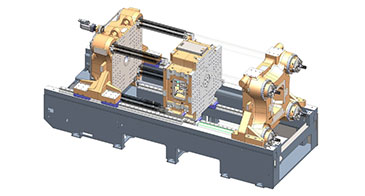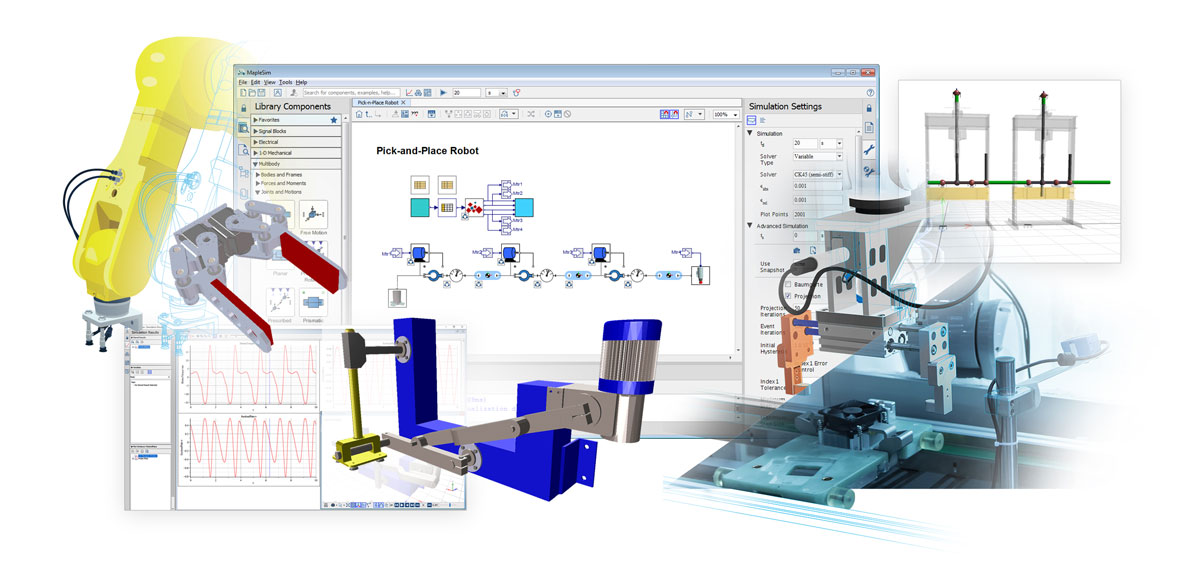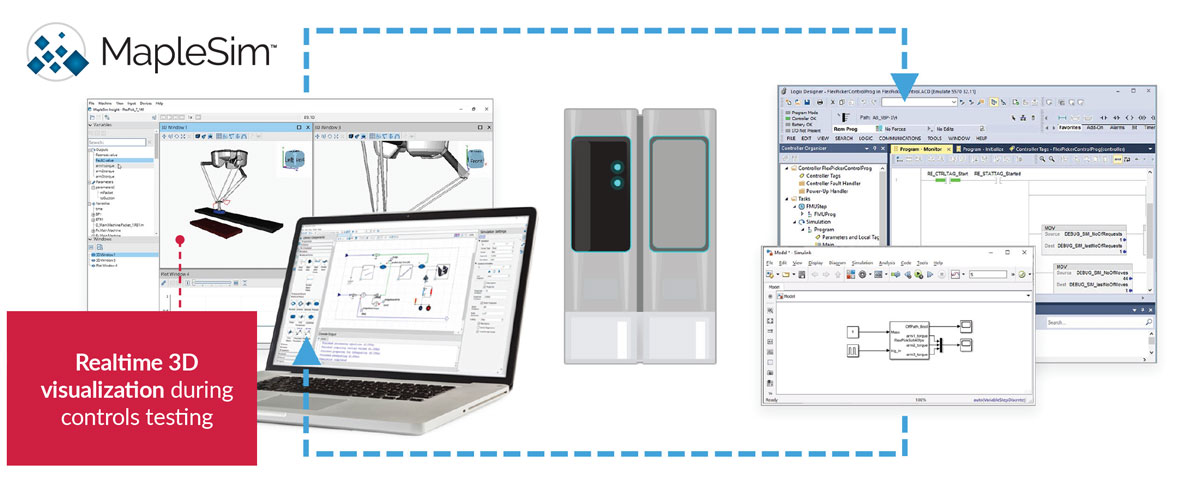User Case Study:
Using Virtual Commissioning to Develop Faster, Safer Machines for Less


In the automation business, speed and efficiency are everything. Engineers are constantly looking for new techniques to increase production speed, without sacrificing safety or quality. To improve machine performance, many engineers look to new motors, hydraulics, and other components that can withstand more demanding requirements. With the advent of virtual commissioning, engineers at Niigon Machines Ltd are making their current machines perform faster, safer, and more efficiently, all by using simulation-based design principles to optimize their products.
As a provider of modern injection moulding machines, Niigon delivers modular, customizable machines to meet the demands of an extremely competitive market. They recently delivered a new machine that ran two injection units in parallel, taking advantage of both hydraulic and electric actuation to press the molds together (Figure 1). Once delivered, their end customer required a faster throughput than was currently achievable for the machine.

Figure 1: A simplified model of Niigon's new injection molding machine, which uses two injection molding units running in parallel.
In its current configuration, the machine speed was limited by unwanted oscillations that would appear at higher production speeds, making it necessary to run the machine slower than the customer’s specification. These oscillations, acting on the center platen, would appear during the portion of the machine cycle when these platens were closing together. Engineers at Niigon explored a variety of options to improve their machine’s configuration. With current engineering techniques, a solution would require replacement of their hydraulic components with electric counterparts, which came at the cost of hardware, hundreds of engineering hours, and significant losses due to machine downtime.
A New Approach: Virtual Commissioning
Faced with high costs and tight deadlines, Niigon decided to consider a new approach to machine optimization. They partnered with Maplesoft, a leading provider of simulation and virtual commissioning solutions, to explore an optimization of their control strategies with simulation-based techniques. If successful, Niigon could solve their problem by precisely optimizing their controllers to minimize the unwanted oscillations – no new hardware required.
What is Virtual Commissioning?
The automation industry has long acknowledged the potential benefits of using virtual models to simulate the performance of physical systems, where integration issues could be spotted before entering into the expensive process of physical integration. Virtual commissioning has been developed as a process to help solve a variety of problems that can arise when manufacturing systems are brought together for integration and operation with a programmable logic controller (PLC). To be successful, the virtual plant model must be an accurate representation of the system, and these models were historically very difficult to create for a typical automation company.
Virtual commissioning, as a concept, was envisioned almost 20 years ago as a promising technique to assist machine development (Auinger et al. 1999). At the time, the hardware capabilities were insufficient to perform meaningful PLC testing at an acceptable cost, especially with the real-time simulation requirements when using hardware PLCs. But technology does not sit still, and as far back as 2006, it was demonstrated that virtual commissioning techniques stood to save up to 75% of the time required for traditional commissioning (Zäh et al. 2006).
Today, new technologies and software integrations are further reducing the historical barriers associated with virtual commissioning. There are tools that can help with everything from sequencing the workflow of an entire assembly line, to testing the control algorithm managing a specific machine’s motion and fault handling. These latter cases typically require a higher fidelity digital model – one that includes a machine’s actual dynamics that can simulate how it moves in response to motor forces and torques.
By linking the system-level modeling environment (such as MapleSim) and the automation design environment (such as the Studio 5000 environment), designers can create their digital models and test their PLC code within the same workflow. This provides valuable feedback during the design phase, where changes are easier and less expensive to implement.
Virtual Commissioning Requirements
Virtual commissioning of a machine’s dynamics generally combines three important pieces: a digital model (sometimes referred to as a digital twin), the controller code that governs the motion and response to sensor feedback, and development environment that allows the two to be run together.
Digital Twins: Physics-Based System Models

Figure 2: The Digital Twin – a physics-based model in MapleSim.
The digital model is a virtual representation of a corresponding physical product. It can be used to simulate, predict and analyze machine performance. These models can range widely in their purpose and fidelity, but they serve as a powerful connection to the product for diagnostics, design changes, and virtual commissioning. Companies are using digital twins across industries, allowing them to optimize their products in ways that were previously impossible.
For clarification, digital twins can also refer to predictive models that are created after a physical product is in operation. In these cases, data logged from sensors on the product are combined with machine learning algorithms to create a representative model of the machine. Although beneficial, these models cannot be used in the virtual commissioning workflow as they require the machine to already be constructed and commissioned (to obtain the data) before they can be used.
In contrast, by using a system-level modeling tool like MapleSim, the creation of a model-driven digital twin can begin alongside the design process. Meaningful digital twins can be created before a physical product is finalized, allowing for a powerful test platform to validate product performance earlier than ever, for important tasks such as sizing servo drives, motors, and gearboxes, as well as validating the mechanism design.
PLC Design
The second key piece of the virtual commissioning workflow is the machine software. The performance of an automated machine is critically dependent on the nature of its control strategy. In operation, the physical machine is controlled by a PLC, which contains all of the necessary information to guide motion, respond to environmental feedback, and ensure that the machine functions properly in all situations.
The design of machine code is often implemented in automation software, where users create control code on a virtual PLC. The control code is then deployed onto a physical PLC, and is connected to physical prototypes to test overall performance in the standard machine commissioning phase. This phase of design poses a large amount of uncertainty and risk, and issues found here can trigger rework, development delays, or machine damage. For these reasons, virtual commissioning can serve as an intermediate process to help identify issues before they’re found during physical machine testing. Furthermore, software implementation and tuning of control parameters can be performed in the office, avoiding expensive on-site commissioning. This thereby allows for improvements in software quality and reduces the time for implementation.
MapleSim Insight
The final piece required for virtual commissioning is an environment, or workflow, that allows the machine software to be run against the digital twin. Historically, integrating system-level modeling and PLC design was challenging, if not impossible. The complex physics of a given digital model were typically simulated using a platform that operated differently than the logic-based systems of PLC design. In 2010, the Functional Mock-up Interface (FMI) was developed as a standard interface for a variety of model-based processes. The FMI standard is a collection of all the necessary information of a given model, organized in a way that allows for import and export with a variety of software tools.
MapleSim Insight is a tool that has taken the integration one step further, by providing a simplified workflow that connects digital twins with PLC design. Digital twins created in MapleSim can be exported as a Function Mock-up Unit (FMU) and used within automation tools (such as Studio 5000 Logix Designer) as a simulation-based test platform. All simulation information, including CAD data, is available within MapleSim Insight, which is controlled via a real-time connection to the automation tool. This tool gives machine designers a new way to simulate, visualize, and validate their control strategy using a highly accurate model of their physical machine. With the included visualization, one can see directly how the machine behaves without first having to analyze complex traces or charts. This visualization allows for a better understanding of the system behavior and helps make the control development faster and easier.
Reducing Cycle Times at Niigon: Developing the Model
To get results as fast as possible, Niigon enlisted the services of Maplesoft Engineering Solutions to help develop and implement a simulation-based upgrade to their machine. Experts at Maplesoft first developed a validated machine model, investigated the underlying causes of oscillations, and then used the simulation model as a virtual test platform for optimizing the machine controllers. By doing their control optimization virtually, Niigon would be able to develop, test, and optimize multiple strategies without taking the physical machine offline, or risking machine damage during testing. Once a suitable strategy was developed, the physical machine was updated remotely with the new software.
To create the simulation model – also known as a digital twin – Niigon provided Maplesoft with a variety of operational data from their machine, including velocity, position, and torque data from different components. Using MapleSim (Figure 3), the modeling and simulation tool from Maplesoft, a dynamic model was created to replicate the operation of the physical machine. To achieve the required fidelity, the model included key components from the physical machine, including hydraulic and mechanical systems, modeled in the same multidomain environment within MapleSim.

Figure 3: An example of the MapleSim workspace, showing the model topology for part of the injection molding machine.
By comparing the physical machine data with the model results, engineers at Maplesoft created a simulation model that accurately replicated the oscillations seen on the physical machine. They could now use this model to investigate the cause for oscillations, and simulate a variety of strategies that could eliminate them from operation.
Optimizing the Control Code
Niigon was now ready to use their simulation model to develop new, optimized control code for the machine. By using a tool like MapleSim Insight, Niigon would be able to connect their simulation model to their control system development tool, and test various control strategies against that model (Figure 4).

Figure 4: Example of the connection between MapleSim (left) and the control system development software (right).
By testing against a virtual machine, Niigon could run countless iterations of control strategies offsite, and without the physical machine. At the click of a mouse, they could visualize their machine’s response to different control strategies, both in the form of specific sensor data and realtime 3-D visualizations of their machine. After optimizing their control strategies virtually, they were ready for deployment on the physical machine.

Figure 5: The physical injection molding machine, developed by Niigon.
Armed with the promising results from their model-based optimizations, engineers from Niigon and Maplesoft were ready to implement their solution on the physical machine (Figure 5). In a typical commissioning situation, engineers might take weeks or months to settle on a suitable controller configuration. However, because Niigon performed their testing on the virtual machine, they required less than two days of machine downtime to implement optimizations to their machine operation.
After implementing two major optimization strategies, Niigon machines successfully reduced the machine cycle time by over 25% (Figure 6), and effectively eliminated the oscillation issues during production. “We initially thought this was impossible to do with software,” noted Billy Jiang, a controls designer for this project. “It was unbelievable when we first got these results.”

Figure 6: By optimizing the machine control code, engineers noticed a significant reduction in oscillations when comparing the hydraulic system without an optimized controller (green) and with the new control strategy (red).
By using virtual commissioning as an automation technology, Niigon was able to deliver a machine that exceeded their customer’s performance requirements, with less machine downtime and less than 25% of the cost of hardware-based solutions. Since optimizing the injection molding machine, the end customer has added a second employee on their line to keep up with the increased production.
The Future of Virtual Commissioning at Niigon
“For me, it’s a total no-brainer. You will never get the best out of your mechanical system without simulation.”

Controls Engineering & IT Manager, Niigon Machines Ltd.
In a matter of months, machine simulation went from a hardly-considered option to an important tool for future engineering developments at Niigon. Marc Ricke, a controls engineer at Niigon, is convinced by the added performance that simulation can bring to their entire product line. “For me, it’s a total no-brainer. You will never get the best out of your mechanical system without simulation.”
What’s next for Niigon? While they can’t say exactly what is under development, Marc is confident that simulation will provide them with a powerful, competitive edge in their future products. In the future, he believes that customers will start to demand the benefits offered by simulation-based machine development.
“In the beginning, CAD modeling was seen as unnecessary, and some people believed they were fine without it. These days, it wouldn’t even be a discussion to debate the necessity of CAD modeling. In 2 years, our hope is that people here will look at simulation the same way.”
 Contact Maplesoft to learn how MapleSim can help with your projects
Contact Maplesoft to learn how MapleSim can help with your projects
Products
Industry/Application Area